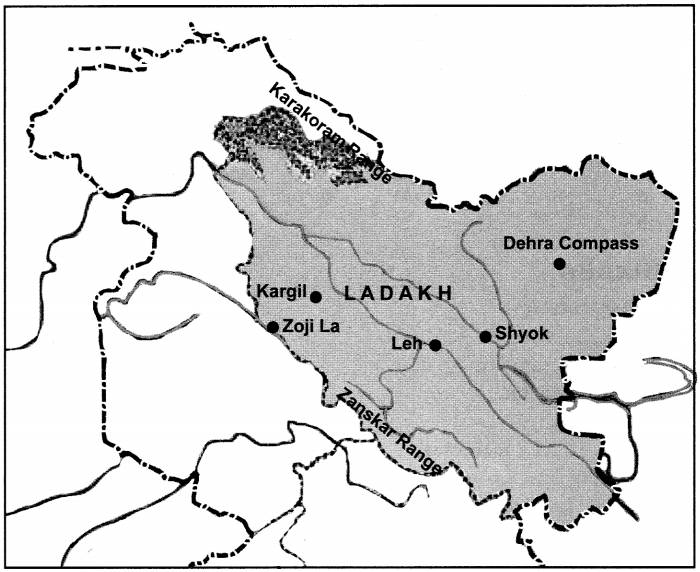Life in the Deserts Class 7 Geography Chapter 10 Extra Questions and Answers Social Science CBSE Pdf free download are part of Extra Questions for Class 7 Social Science. Here we have given NCERT Extra Questions for Class 7 Social Science SST Geography Chapter 10 Life in the Deserts.
You can also practice NCERT Solutions for Class 7 Geography Chapter 10 Questions and Answers on LearnInsta.com.
Class 7 Geography Chapter 10 Extra Questions and Answers Life in the Deserts
Life in the Deserts Class 7 Extra Questions and Answer Geography Chapter 10 Very Short Answers Type
Question 1.
Which is the essential component for habitation?
Answer:
Water is an essential component of life. It is very difficult to live on the places where there is no water.
Question 2.
Name the world’s largest desert.
Answer:
Sahara is the world’s largest desert.
Question 3.
Where is Sahara desert located?
Answer:
Sahara desert covers a large part of North Africa.
Question 4.
What area is covered by the Sahara desert?
Answer:
It has an area of around 8.54 million s km.
Question 5.
How many countries are touched by the Sahara desert? Mention there names.
Answer:
The Sahara desert touches 11 countries. These are Algeria, Chad, Egypt, Libya, Mali, Mauritania, Morocco, Niger, Sudan, Tunisia and Western Sahara.
Question 6.
Name the vegetation found in the Sahara desert.
Answer:
Cactus, date palms and acacia etc., are vegetation found in the Sahara desert. In some places there are oasis-green islands with date palms surrounding them.
Question 7.
Name the animals found in the Sahara desert.
Answer:
Camels, hyenas, jackals, foxes, scorpions, many varieties of snakes and lizards are the prominent animal species living there.
Question 8.
Name the nomadic tribes living in the Sahara desert.
Answer:
The Bedounis and Tuaregs are nomadic tribes live in the Sahara desert.
Question 9.
Name the places where settled population is found.
Answer:
The oasis in the Sahara and the Nile Valley in Egypt supports settled population.
Question 10.
What is grown by the people of Sahara desert?
Answer:
The people grow date palms, rice, wheat, barley and beans and Egyptian cotton which is famous worldwide.
Question 11.
Name the minerals found in the Sahara desert.
Answer:
In the Sahara desert oil, iron, phosphorus, manganese and uranium are found.
Question 12.
Name the capital of Ladakh.
Answer:
Leh is the capital of Ladakh.
Life in the Deserts Class 7 Extra Questions and Answer Geography Chapter 10 Short Answers Type
Question 1.
Which areas are called desert?
Answer:
Some places are very hot as fire while some are very cold as ice. These are the desert areas of the world. Depending on the temperatures, these may be hot desert or cold deserts.
Question 2.
What is found besides the vast stretches of sands in the Sahara desert?
Answer:
Besides the vast stretches of sands, there are also gravel plains and elevated plateaus with bare rocky surface. These rocky surfaces may be more than 2500m high at some places.
Question 3.
Describe the climate of the Sahara desert.
Answer:
The climate of the Sahara desert is scorching hot and parch dry. It has a short rainy season. Days are unbelievable hot, it may be as high as 50°C while nights may be freezing cold with temperatures nearing 0°C.
Life in the Deserts Class 7 Extra Questions and Answer Geography Chapter 10 Long Answers Type
Question 1.
Write a short note on Sahara desert.
Answer:
Sahara is the world’s largest desert. Sahara desert covers a large part of North Africa. It has an area of around 8.54 million s km. The Sahara desert touches 11 countries. These are Algeria, Chad, Egypt, Libya, Mali, Mauritania, Morocco, Niger, Sudan, Tunisia and Western Sahara. Besides the vast stretches of sands, there are also gravel plains and elevated plateaus with bare rocky surface. These rocky surfaces may be more than 2500 m high at some places.
The climate of the Sahara desert is scorching hot and parch dry. It has a short rainy season. Days are unbelievable hot, it may be as high as 50°C while nights may be freezing cold with temperatures nearing 0°C. Cactus, date palms and acacia etc., are vegetation found in the Sahara desert.
In some places there are oasis-green islands with date palms surrounding them. Camels, hyenas, jackals, foxes, scorpions, many varieties of snakes and lizards are the prominent animal species living there.
Question 2.
Write a short note on cold desert of Ladakh.
Answer:
Ladakh is a cold desert lying in the Great Himalayas, on the eastern side of Jammu and Kashmir. The Karakoram Range in the north and the Zanskar mountains in the south enclose it. River Indus and Gangri glacier are found in Ladakh.
The altitude (height) in Ladakh varies from about 3000 m in Kargil to more than 8,000 m in the Karakoram. Due to its high altitude, the climate is extremely cold and dry. The day temperatures in summer are just above 0°C and the night temperatures well below -30°C. There is little rainfall, as low as 10 cm every year.
Question 3.
Describe about the vegetation and animals found in Ladakh.
Answer:
Due to high aridity in Ladakh, the vegetation is sparse. There are scanty patches of grasses and shrubs for animals to graze. Groves of willows and poplars are seen in the valleys. Fruit trees such as apples, apricots and walnuts are found during the summers. Robins, redstarts, Tibetan snow-cock, raven and hoopoe are found commonly.
The animals of Ladakh are wild goats, wild sheep, yak and special kinds of dogs. Yak’s milk is used to make cheese and butter. The hair of the sheep and goat is used to make woolens. In the summer season the people are busy cultivating barley, potatoes, peas, beans and turnip.
Picture Based Questions Class 7 Geography Chapter 10 Life in the Deserts
Question 1.
On an outline map of India, show Ladakh desert.
Answer:
